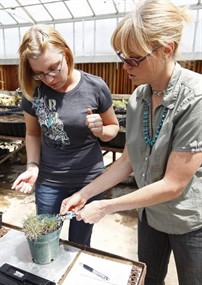Scientist in training
April 2009
by Janice Gibbs- Telegram Medical Writer
Erin Witherington spent part of her 11-week internship with the Grassland, Soil and Water Research Laboratory knee deep in sludge taking soil samples. She was happy to do it.
Witherington is finishing her degree in the Biotechnology Program of the Texas Bioscience Institute. Thursday she will give her internship presentation on “The Role of Biotechnology in Agroecology.”
The two-year associate degree in applied science prepares students to work in the biotechnology field, including medical research, forensics and agriculture research.

The Temple area is rich in resources for medical and clinical research, said Katie Burrows, chair of the department of associate of applied science in biotechnology.
It’s no surprise that many of the students choose to focus on medical and clinical research, but Witherington had different preferences.
“Erin liked the molecular research work, but she was also interested in environmental issues – remediation and biofuels,” Burrows said.
She contacted USDA Agriculture Research Service and Grassland, Soil and Water Research Laboratory in Temple to see if they would be willing to take Witherington as an intern.
Witherington works with Dr. Virginia Jin, ecologist, and Dr. Mari-Vaughn Johnson, research agronomist, both with the U.S. Department of Agriculture, Agriculture Research Service and Grassland, Soil and Water Research Laboratory.
Jin and Johnson are working on a grant with the Hornsby Bends Biosolids Project – where Austin’s sewage and yard trimmings are recycled and turned into biosolids applied to land or turned into Dillo Dirt, a natural compost.
Soil samples are collected to ascertain nitrogen and carbon content. Soil chemistry analysis looks at trace metal content to determine if it’s in an acceptable range, because the land is used to grow hay for farm animals.
Since Hornsby Bends is close to the Colorado River, runoff is a concern. It’s also a bird habitat and that has to be considered when looking at the health of the land.
When Witherington began her internship, she was able to hit the ground running and start collecting soil samples, Johnson said.
Witherington has been processing the core samples taken at different areas in the Hornsby Bends site.
The cores are cut into small pieces, dried out, then tested to see what’s getting down into the soil, depending on the amount of waste applied in that area.
Witherington also works with Jim Kiniry on biofuels research.
“We try to make it as dynamic as we can for the intern,” Johnson said. “Erin has been exposed to all types of work – in the lab, field and greenhouse. We’ve been very impressed with her work, and Jim Kiniry has been able to extend her internship through the summer.”
This internship is great for young potential scientists, because they can get their feet wet, she said. They can find out what it’s really like to get out and take soil cores samples filled with municipal waste.
“I’ve smelled worse,” Witherington said.
The research community is losing soil scientists, losing people who might be interested, Johnson said.
“It may be a disconnect in the school between students and the environment,” she said. “You ask a kid where his shirt came from and the answer will be Wal-Mart rather than cotton.”
Students in the biotechnology program take the typical science and math classes required during the first year of most allied health classes. In the second year, the classes include laboratory instrumentation, laboratory methods and techniques, cell culture techniques.
Students who complete the biotechnology program are likely to continue their education.
“It’s a rigorous course load,” Burrows said. “It teaches really good skills. Researchers who have worked with the biotechnology students appreciate that the students know how to use the equipment. Our goal is to have the students well prepared for the frontline basics of working in a research lab.”
No matter what direction the students go, the same methodologies, techniques, basic skills and instruments are used, she said.
Biotechnology students have had internships at Scott & White, A&M College of Medicine and the VA.
One of the interns, Burrows said, is pursuing a four-year degree, one was hired in the lab where they had been working and another is now working at the Institute of Regenerative Medicine.
Witherington, who will move to Kentucky when her husband returns from Afghanistan, has been looking at what jobs are available there.
She was working on a bachelor’s degree in clinical laboratory science when she moved to Texas.
“I visited TC and they sent me to the Texas Bioscience Institute,” Witherington said. “They worked with me to get financial aid and here I am.”
Her goal is to get her master’s degree. “Even if I did leave the biotechnology field I’ve learned a lot,” she said.
The internships are where the students get their feet in the door and receive real-world experience, Burrows said. The classroom is good, but it can’t take the place of hands on activity.
“If Mrs. Burrows has another student who is interested in doing ecological or agronomic research, we’re certainly willing to host that person.” Jin said “It’s worked out fabulous for us.”
The Texas Bioscience Institute, its middle college for high school students and its college level programs, are a reality because the business community, Temple College, Scott & White, the VA and area school districts worked together to make it happen, Burrows said.
As biotechnology industry expands in Temple and startup companies move here, it will be possible for the Texas Bioscience Institute to tailor instruction to meet their needs, she said.
–Reprinted with permission of Temple Daily Telegram
